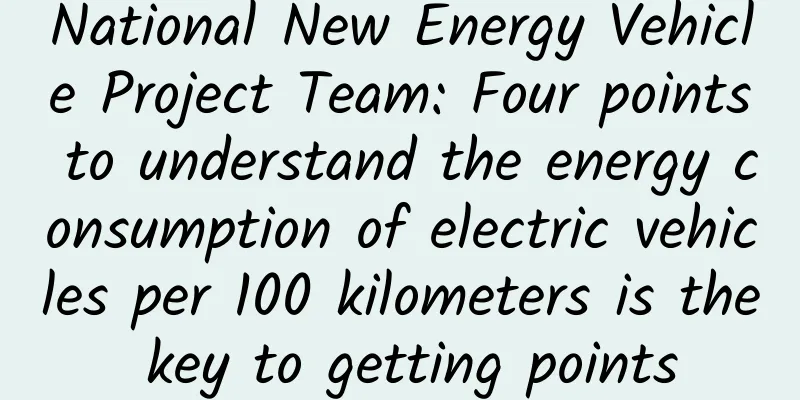National New Energy Vehicle Project Team: Four points to understand the energy consumption of electric vehicles per 100 kilometers is the key to getting points

|
Statistics show that China consumed 556 million tons of oil in 2016, of which about half was consumed by automobiles. With resource shortages and environmental deterioration, energy conservation and emission reduction have become the main theme of the current development of the automobile industry. As a strategic industry in my country, new energy has become an important measure to achieve the sustainable development strategy of the automobile industry. In 2016, the production and sales of new energy vehicles in my country reached 605,000 and 608,000 respectively. According to the 13th Five-Year Plan, by 2020, the cumulative production and sales of new energy vehicles in my country will reach a phased goal of 5 million. Regarding the current development status of new energy vehicles in my country, Wang Binggang, leader of the supervision and consulting expert group of the major project "Energy Saving and New Energy Vehicles" of the National 863 Plan, pointed out at a seminar on lubricant and engine technology trends that China's new energy vehicles are still in the introduction stage. He believes that the price-performance ratio of products in the current introduction stage is not competitive yet, the government needs to do a lot of work, subsidies are still the main incentive policy, infrastructure needs to be built, and as the industrial chain grows and consumers become aware of it, companies also need to explore and establish effective business models. By 2020, it will enter a period of rapid development, with policy as the main driving force turning into market as the main driving force. Products will be competitive in some major areas, infrastructure will meet basic needs, the industrial chain will be initially built, car purchase subsidies will be withdrawn, and replaced by conventional incentive policies in the fields of environment and energy. Companies will establish a number of effective business models, and consumers will have a high degree of awareness and satisfaction. On the current controversial issue of carbon emissions from electric vehicles, Wang Binggang clarified his understanding of electric vehicles from four aspects. Wang Binggang, leader of the National "Energy-Saving and New Energy Vehicle" Major Project Supervision and Consulting Expert Group, gave a report at the Lubricant and Engine Technology Trend Seminar 1. Electric vehicles are not zero-carbon Wang Binggang pointed out that electric vehicles in China do not emit zero carbon emissions. He talked about Tesla being fined in Singapore for carbon emissions. Because Singapore relies on fossil energy for electricity generation, which emits carbon dioxide, and cars using electricity means emitting carbon dioxide, in 2016, the Land Transport Authority of Singapore identified the Tesla Model S as a "non-environmentally friendly model" and imposed a tax of $15,000 on the owner. The Land Transport Authority of Singapore calls the emission of 500 grams of carbon dioxide per kWh of electricity a "carbon emission factor". The carbon emission factor is multiplied by the power consumption of the Model S per 100 kilometers to get the carbon dioxide emissions per kilometer of Tesla. From Singapore's algorithm, it can be seen that electric vehicles that seem to be "zero-emission" still have a lot of indirect pollution and emissions in the chain from power generation to battery equipment. "Singapore converts the electricity consumed by electric vehicles into carbon dioxide emissions, and as a result, the carbon dioxide emissions of the Model S exceed the standard, with electricity consumption possibly reaching 40 degrees per 100 kilometers. We should refer to Singapore's principle," said Wang Binggang. "Singapore's electricity is all generated by fossil energy, while my country's fossil energy accounts for 70% of its electricity generation energy, and renewable energy or non-fossil energy accounts for 30%, which is lower than Singapore's carbon emission factor. China will continue to increase the proportion of renewable energy in the future." 2. Electric vehicles have significantly lower carbon emissions than gasoline vehicles According to Singapore's carbon emission factor data, from power generation to the use of the entire vehicle life cycle, fuel vehicles will emit 3,000 grams of carbon dioxide per liter of fuel. "Electric vehicles consume about 10 to 30 degrees per 100 kilometers, and emit 5,000-15,000 grams of carbon dioxide, while fuel vehicles can consume as little as 5 liters of fuel per 100 kilometers. SUVs consume even 15 liters of fuel, and may even consume 18 liters of fuel, and emit carbon dioxide ranging from 15,000 to 54,000 grams." It can be seen that the carbon emissions of electric vehicles are significantly lower than those of fuel vehicles, and as the proportion of renewable energy generation increases, their carbon emissions will be lower than those of fuel vehicles. At present, the carbon emissions of electric vehicles in my country are lower than the carbon emissions of 5 liters of oil. "There is controversy in the industry that electric vehicles are not environmentally friendly, but from these data, it can be clearly said that electric vehicles are environmentally friendly products. Electric vehicles that consume more than 30 degrees of electricity per 100 kilometers have very low carbon emissions. We are sure of this." Wang Binggang said. 3. Carbon emissions are directly proportional to energy consumption levels Wang Binggang said that the carbon emissions of electric vehicles are directly proportional to the energy consumption per 100 kilometers, and the energy consumption per 100 kilometers is related to the size of the electric vehicle. The larger and heavier the body or the longer the driving range, the higher the power consumption. "When discussing carbon emission indicators, according to the draft opinion of the Ministry of Industry and Information Technology, the higher the driving range, the more carbon emission indicators will be given. In fact, the longer the driving range, if the car is heavier, the higher the energy consumption per 100 kilometers, the more carbon emissions, and it is not suitable for rewards. The increase in driving range is worthy of recognition as a technological progress, but it is not suitable as a basis for carbon emission rewards." "When the country formulates carbon emission points, it should link driving range and electricity consumption per 100 kilometers. Points can only be rewarded when both are taken into account. Even if the driving range is longer, if the electricity consumption per 100 kilometers is too high, points will still be deducted. This will not only encourage technological progress in driving range, but also take into account electricity consumption per 100 kilometers and carbon emissions, which is very important." Wang Binggang pointed out. 4. Carbon emissions from high-power electric vehicles are comparable to low-fuel gasoline vehicles According to the calculation in the second point above, during the entire life cycle of the vehicle from power generation to use, a fuel vehicle will emit 3,000 grams of carbon dioxide per liter of oil. A high-energy-consuming electric vehicle consumes about 30 degrees per 100 kilometers and emits about 15,000 grams of carbon dioxide, while a fuel vehicle can consume as little as 5 liters of oil per 100 kilometers and emits only 15,000 grams of carbon dioxide. This shows that in fact, the carbon emissions of a high-power-consuming electric vehicle are comparable to those of a low-fuel-consuming gasoline vehicle. In addition to a clear explanation of the current controversial issues regarding carbon emissions from electric vehicles, Wang Binggang also emphasized the definition of new energy vehicles. He pointed out that to distinguish whether a vehicle is new energy, a full life cycle evaluation should be conducted from the energy production, storage and transportation process to the vehicle manufacturing and use process. At present, there are no absolutely clean new energy vehicles, only relative concepts. Energy saving means emission reduction. "China has determined that pure electric drive (including EV, PHEV, FEV) is the main direction of new energy vehicles. At the same time, HEV and other technologies are used to reduce automobile energy consumption. Natural gas HEV vehicles also have good application prospects." Wang Binggang said that the new energy vehicle industry is expected to enter a period of rapid development in 2020. The new energy vehicle industry should actively respond to policy adjustments, develop market-competitive products, and speed up the improvement of infrastructure to create conditions for large-scale promotion. The government should also continue to improve the policy system to ensure the continued and steady development of new energy vehicles. As a winner of Toutiao's Qingyun Plan and Baijiahao's Bai+ Plan, the 2019 Baidu Digital Author of the Year, the Baijiahao's Most Popular Author in the Technology Field, the 2019 Sogou Technology and Culture Author, and the 2021 Baijiahao Quarterly Influential Creator, he has won many awards, including the 2013 Sohu Best Industry Media Person, the 2015 China New Media Entrepreneurship Competition Beijing Third Place, the 2015 Guangmang Experience Award, the 2015 China New Media Entrepreneurship Competition Finals Third Place, and the 2018 Baidu Dynamic Annual Powerful Celebrity. |
>>: The UK has invested heavily in the Faraday Challenge program to develop battery technology
Recommend
How to maintain seed users and enable them to optimize and spread products?
Maintaining seed users is actually a matter of co...
How to use digital DPD technology to reduce the cost and increase the efficiency of router chip kits?
Part 01 Cost Advantage Currently, wireless networ...
How to protect your knees when running?
People often tell me that their knees hurt after ...
Why doesn't Samsung S7 use USB Type-C?
As we all know, USB Type-C will replace the exist...
Writing copy is not to attract attention, but to occupy your time!
The purpose of writing copy is to gain as much us...
Is Hon Hai anxious after failing to complete the acquisition of Sharp in June?
According to the Nikkei News, Hon Hai was unable ...
"Dou Ke Chuang Zao Ying" topic structure content packaging, write good lessons, record good lessons, and sell good lessons
Training course video lecture content introductio...
9 treasure APPs that you can't bear to uninstall even if you change your phone. Each one is carefully selected, please use it in a low-key manner
I believe everyone has a lot of apps on their pho...
Case analysis: How to avoid the pitfalls of WeChat community operations?
The preliminary preparations for community operat...
A new breakthrough in low-altitude economy! The first scientific research flight of a domestically-made manned airship, what’s the point?
On February 21, my country's independently de...
Sony Z3 is about to break through and refresh your "view of mobile phones"
Sony Z3 will be unveiled at IFA2014 on September ...
Electric Technology Car News: Why is the speed limit on highways 120? Cars are designed to run at 200+
As the saying goes, "Nine out of ten acciden...
Five major factors and optimization methods for Toutiao information flow advertising conversion
The main reason that affects the conversion rate ...
iPhone SE and iPhone 6S are easy to refurbish: Apple needs to reflect
Hong Kong media recently pointed out that many st...
How should marketing campaigns be designed?
The purpose of marketing activities is mainly to ...









